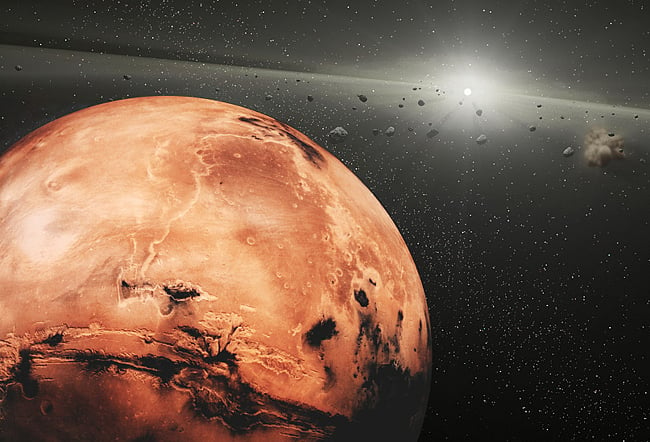This article is more than 1 year old
BLUSHING asteroids lose their red space tan when they visit the Red Planet MARS
Space rocks lose rosy glow thanks to Martian gravity
Astroboffins have found that the gravity well of Mars churns the surface of passing asteroids, causing them to lose their natural, blushing space tan.

Scientists have put much effort into figuring out why asteroids appear redder than meteorites - the bits of the space rocks that crash into the Earth. Three years ago, MIT professor of planetary sciences Richard Binzel suggested that the asteroids might be blushing because of their exposure to cosmic radiation, which changes the chemical nature of their surface and makes them redder over time.
When asteroids stray out of the main asteroid belt between Mars and Jupiter, Earth's gravity shakes them up, causing surface quakes that reveal the fresh, non-cosmiscally-tanned layer underneath. If the asteroid is unlucky enough to get too close to our planet, it breaks up and falls to the surface as meteorites.
Now Binzel and his colleagues Francesca DeMeo and Matthew Lockhart have found that Mars can do the same thing to passing space rocks.
If the asteroids pass close enough to the Red Planet, they experience the same quakes and perversely end up less red.
“We don’t think Earth is the only major driver anymore, and it opens our minds to the possibility that there are other things happening in the solar system causing these asteroids to be refreshed,” DeMeo said.
Even though Mars is only a third the size of Earth and a tenth as massive, with a much weaker gravitational pull, it's quite close to the asteroid belt, upping the chances that a space rock will fly by close enough to be affected.
The team has been tracking the brightest asteroids from a database created by the International Astronomical Union's Minor Planet Centre of 300,000 asteroids, 10,000 of which are near-Earth.
For this study, the researchers mapped the orbit of 60 space rocks, checking which intersected with the orbits of Earth or Mars or which could have over the last half a million years.
“Picture Mars and an asteroid going through an intersection, and sometimes they’ll both come through at very nearly the same time,” Binzel explained. “If they just barely miss each other, that’s close enough for Mars’ gravity to tug on [the asteroid] and shake it up. It ends up being this random process as to how these things happen, and how often.”
Ten per cent of the asteroids only crossed the Martian orbit, not Earth's, and other potential causes - like the space rocks crashing into each other or "spin-up", where energy from the Sun causes the asteroids to spin faster and faster - were ruled out.
"Mars is the only game in town," Binzel said.
The full study, "Mars encounters cause fresh surfaces on some near-Earth asteroids", was published in the Icarus journal. ®
